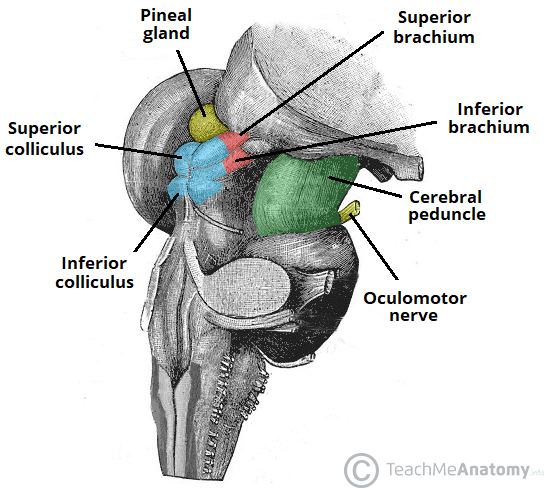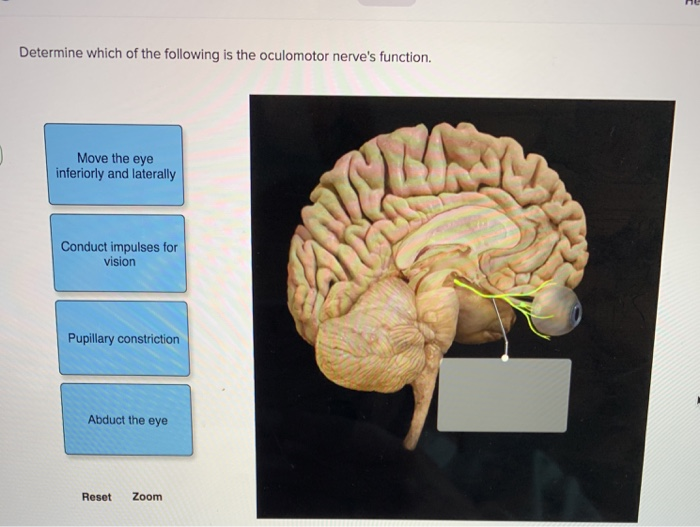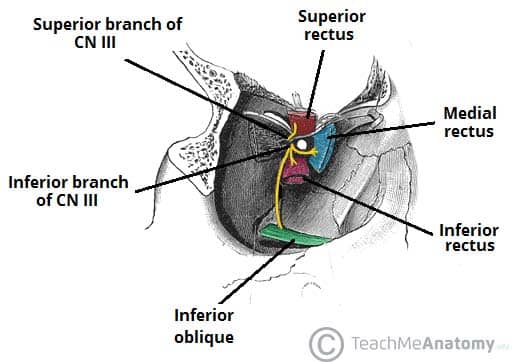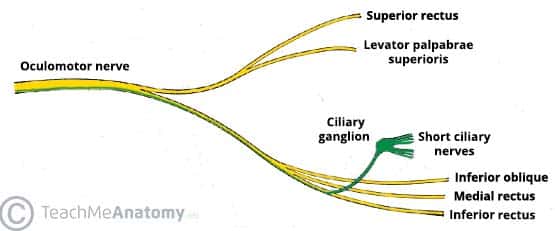Determine Which of the Following Is the Oculomotor Nerve's Function.
When inspecting a clients eyes the nurse assesses the presence of cranial nerve III oculomotor cranial nerve by observing as the eyelids open and close bilaterally and also by testing. Adduction medial rectus muscle.

Solved Optic Chiasm Trochlear Nerve Iv Oculomotor Nerve Chegg Com
Levator palpabrae superioris raises the upper eyelid.

. Determine if the patient can see anything C. Additionally there are sympathetic fibres that travel with the superior branch of the oculomotor nerve. Olfactory nerve CN I enables sense of smell.
Lid elevation levator muscle. It emerges from the ventral aspect of midbrain in the interpeduncular fossa between posterior cerebral and superior cerebellar arteries. It allows movement of the eye muscles constriction of the pupil focusing the eyes and the position of the upper eyelid.
Lateral rectus abducens is still intact and so the pulls the eye out and the superior oblique. Damage to the oculomotor nerve interrupts motor input to the majority of extraocular muscles including most of the recti and the inferior oblique as well as the levator palpebrae superioris the sphincter pupillae and the ciliary muscles. Simply from the name then it is easy to know that the oculomotor nerve will innervate muscles that move the eye itself or components of the eye.
Cranial nerve III works with other cranial nerves to control eye movements and support sensory functioning. Determine if the patient still has night vision. The two 3rd cranial nerves oculomotor nerves are located at the top of the brainstem - one to the right and one to the left.
The oculomotor nerve is responsible for the majority of eye and eyelid movements although the trochlear nerve and abducens nerve also contribute to eye movements. The oculomotor nerve controls eye movements. The oculomotor nerve is the third cranial nerve CN III.
Elevation when eye is adducted inferior oblique muscle. Have the patient look superiorly and inferiorly D. They are Lower Motor Neurons LMN second order neurons.
It controls most of the eye movements cranical nerves IV and VI also do some constriction of the pupil and holding the eyelid. The visceral motor function provides parasympathetic innervations to the constrictor pupillae and ciliary muscles. Mydriasis as the parasympathetic fibres of the oculomotor nerve surround the motor fibres.
In the normal cranial nerve III the nerve function and position of eye are as follows. Its nuclei lie in midbrain at the level of superior colliculus. Have the patient distinguish between green and red colors B.
The oculomotor nerve is the third of twelve paired cranial nerves. Pupil constriction pupil sphincter muscle. Select which cranial nerve has sensory fibers that monitor blood pressure at the carotid Sinus.
Oculomotor nerve palsy. Runs forward in the lateral wall of. Determine if the patient can see anything.
Optic nerve CN II enables vision. The optic nerve II is the agent of vision. They control eye muscles on the same side of the body ipsilateral.
Number Name Function Location. Last medically reviewed on April. Somatosensory information touch pain from the face and head.
This nerve helps to feel the sense of smell. Asked Nov 9 2016 in Health Professions by Chelsea. Why is the eye in a down and out position in oculomotor nerve palsy.
If the abducens and trochlear nerves are unaffected the actions of the lateral rectus and superior. The oculomotor nerve is entirely motor It is responsible for lifting the upper eyelid. The oculomotor nerve provides movement to most of the muscles that move the eyeball and upper eyelid known as extraocular muscles.
The oculomotor nerve is responsible for the majority of eye and eyelid movements although the trochlear nerve and abducens nerve also contribute to eye movements. Oculomotor nerves are responsible for which of the following functions. The oculomotor nerve helps control muscle movements of the eyes.
Have the patient distinguish between green and red colors. The 3rd cranial nerves are pure motor nerves. The oculomotor nerve has two distinct functions the somatic motor that supplies four of the six extraocular muscles of the eye and the levator palpabrae superioris muscle of the upper eyelid.
Our facial muscles help us to determine emotion and the jaw muscle helps us form words. The oculomotor nerve. Depression when eye is abducted inferior rectus muscle.
If the oculomotor nerve is compressed which symptom is the first to be seen and why. The oculomotor nerve also known as the third cranial nerve cranial nerve III or simply CN III is a cranial nerve that enters the orbit through the superior orbital fissure and innervates extraocular muscles that enable most movements of the eye and that raise the eyelid. Oculomotor nerve is the 3 rd cranial nerve.
Damage to this nerve may result in distortion of smell and taste. The motor functions of the trigeminal nerve make it possible for people to chew and clench teeth and they give sensation to the muscles in their ears. The nerve also contains fibers that innervate the intrinsic eye muscles that enable pupillary constriction and.
They sit at the level of the tentorium. Superior rectus elevates the eyeball. Pupillary contraction Determine which of the following is the oculomotor nerves function.
These muscles move the eyeball and upper eyelid. The oculomotor nerve is the third cranial nerve CN III and one instance in which the name is a clear indication of the function of the nerve Oculo pertaining to the eye motor producing movement. Elevation when eye is adbucted superior rectus muscle.
This is the primary nerve that is responsible for the smell. Following is the cranial nerves list along with the important functions they perform. Asked Sep 27 2016 in Anatomy Physiology by polishaddict.
Have the patient cry E. Which of the following would help to determine if the oculomotor nerve was damaged. Which of the following would help to determine if the oculomotor nerve was damaged.
It Is purely motor nerve. What is the origin and course of Oculomotor nerve. It is the largest cranial nerve.
The oculomotor nerve innervates many of the extraocular muscles.

Solved Distinguish The Oculomotor Nerve Cn Iii From The Chegg Com

Dear Nurses Simplifying The Cranial Nerves Cranial Nerves Craniosacral Therapy Nursing School Tips

Functions Of The Cerebral Cortex Cerebral Cortex How To Memorize Things Powerful Computer

The Oculomotor Nerve Cn Iii Course Motor Teachmeanatomy
(251).jpg)
Cranial Nerves Quiz Human Anatomy Physiology Proprofs Quiz

Cranial Nerves Tricks Mnemonics Pares Craneales Anatomia Del Esqueleto Humano Anatomia Medica
:watermark(/images/watermark_only_sm.png,0,0,0):watermark(/images/logo_url_sm.png,-10,-10,0):format(jpeg)/images/anatomy_term/nervus-oculomotorius-2/utoGCjHCIisphHvijmp2QA_3.Occulomotor_Nerve.png)
Oculomotor Nerve Cn Iii Anatomy Function And Pathway Kenhub

Solved Determine Which Of The Following Is The Oculomotor Chegg Com

The Oculomotor Nerve Cn Iii Course Motor Teachmeanatomy

Sheep Brain External Anatomy Ventral Dollar Store Christmas Crafts Abducens Nerve Hypoglossal Nerve

Cranial Nerves Cranial Nerves Brain Nerves Cranial Nerves Function

Ot 716 Cranial Nerves Unit 3 Flashcards Quizlet

Cranial Nerves Quizzes And Labeling Exercises Cranial Nerves Facial Nerve Nerve Anatomy

Solved Abducens Oculomotor Trochlear Inferior Oblique Chegg Com

Cranial Nerves On Models Labeled Brain Model Somso Nervous System Anatomy Anatomy And Physiology Brain Anatomy
:watermark(/images/watermark_only_sm.png,0,0,0):watermark(/images/logo_url_sm.png,-10,-10,0):format(jpeg)/images/anatomy_term/nervus-oculomotorius-4/h60spVfMnT5nyQHKyCNeoA_Oculomotor_nerve.png)
Oculomotor Nerve Cn Iii Anatomy Function And Pathway Kenhub

Cranial Nerves Brain Anatomy Human Anatomy And Physiology Medical Anatomy

The Oculomotor Nerve Cn Iii Course Motor Teachmeanatomy

Examining The Trigeminal Nerve Medical School Studying Nursing School Survival Nursing School Studying
Comments
Post a Comment